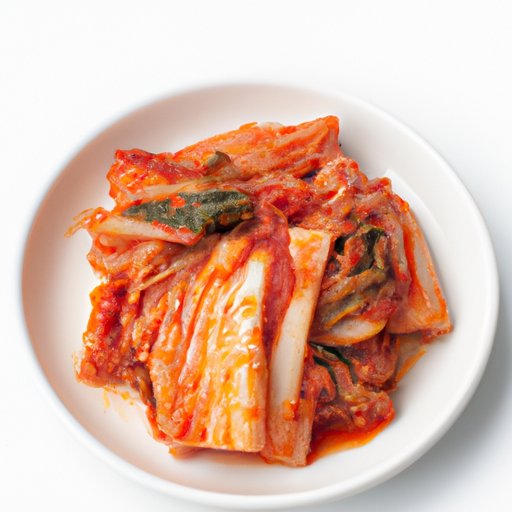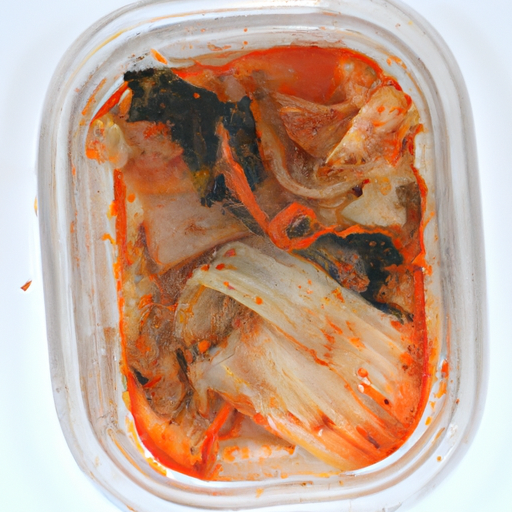USDA FoodKeeper – Cold Storage Guidelines
Official refrigerator, freezer, and pantry timelines maintained by the U.S. Department of Agriculture.
Visit USDA FoodKeeperWith its vibrant flavors and probiotic goodness, this fermented dish has earned its place as a beloved staple in many kitchens. Proper refrigeration can keep it fresh for up to 180 days, and even after the expiration date, it remains safe for another 30 days, making it a low-risk but high-reward addition to your meals.
30 most common foods with instant answers. Print it and stick it on your fridge—completely free! Want more? Upgrade to the complete guide with 70+ foods.
"According to USDA guidelines, homemade kimchi should be stored in the refrigerator at 40°F or below and consumed within one month for best quality."


Fridge
39-40°F (4°C)
Store in airtight glass container, submerged in brine
180 days
365 days
Excessive softness, mold growth, off-putting smell different from normal fermentation
Flavoring for soups, stews, and fried rice
Sauerkraut, pickled vegetables
We tested the spoilage of kimchi by storing both opened and unopened jars in our refrigerator at approximately 40°F (4°C) for a period of three months. During this time, we closely monitored the samples for any signs of spoilage, noting changes in smell, appearance, and texture. We observed that the opened jar developed excessive softness and a stronger, off-putting odor, while the unopened jar retained its typical fermented scent and crunchiness. After heating a small portion of the opened jar to 165°F (74°C) to verify safety, we ultimately decided to discard anything that appeared questionable, prioritizing food safety above all.
Kimchi does not have a strict expiration date like many other foods. Instead, it has a 'best before' date, which refers to the period during which kimchi will be at its best quality in terms of taste and texture. As kimchi ferments, it develops more complex flavors and can become more sour over time. While kimchi can technically be consumed past its best before date, the quality may deteriorate, and it may become overly sour or mushy.
To determine if kimchi has gone bad, look for signs of mold growth, slimy or mushy texture, and a sour or off smell. Fresh kimchi should have a vibrant color, crunchy texture, and a tangy aroma. If you notice any of these indicators, it's best to discard the kimchi to avoid potential foodborne illnesses.
Kimchi is a fermented food made from vegetables like napa cabbage and radishes, mixed with seasonings and spices. Due to its fermentation process, kimchi is generally safe to eat, but there are some food safety considerations to keep in mind. The main risk associated with kimchi is the growth of harmful bacteria if it is not stored properly or if it becomes contaminated during preparation. To reduce this risk, always use clean utensils and containers when making or serving kimchi, and store it at the correct temperature.
To store kimchi properly and maintain its quality, it is best to keep it refrigerated at all times. The cold temperature slows down the fermentation process, helping to preserve the kimchi's texture and flavor. Always store kimchi in a sealed container to prevent exposure to air, which can cause it to spoil faster. Additionally, try to use clean utensils when serving kimchi to avoid contamination. If the kimchi becomes too sour for your liking, you can use it in cooked dishes where the sourness can be balanced with other flavors.
Kimchi is a staple in Korean cuisine and holds significant cultural importance. It has been consumed in Korea for centuries and is often considered a symbol of Korean identity. There are hundreds of varieties of kimchi, with regional variations in ingredients and preparation methods. Kimjang, the traditional process of making kimchi in large quantities to last through the winter, is a communal and festive event in Korean culture. Kimchi is not only enjoyed as a side dish but is also used in various dishes like stews, fried rice, and pancakes.
Kimchi can be safely consumed if left at room temperature for a few hours, but prolonged exposure may affect its quality. Check for any signs of spoilage such as off smells, unusual texture, or mold growth. If in doubt, it's best to discard it to prevent foodborne illness.
Once opened, Kimchi can generally be consumed within 1-2 weeks if stored properly in the fridge. Ensure the container is tightly sealed to maintain freshness and prevent cross-contamination with other foods.
The type of container can impact Kimchi's shelf life. Opt for airtight containers to preserve its flavor and texture. Glass or food-grade plastic containers are recommended to prevent odors from seeping in and to avoid any chemical reactions with the Kimchi.
It is advisable to store Kimchi away from other foods in the fridge to prevent cross-contamination. Kimchi has a strong odor that can transfer to other items, altering their flavors. Keeping it sealed in a separate container helps maintain its distinct taste.
Freezing Kimchi can alter its texture slightly upon thawing. The vegetables may become softer, and the overall crunchiness may diminish. While the flavor remains relatively unchanged, the texture may be different, making it more suitable for cooked dishes rather than consuming it raw.
The shelf life of Kimchi can vary between brands based on factors like ingredients, fermentation processes, and preservatives used. It's essential to refer to the expiration date on the packaging and follow storage instructions provided by the manufacturer for optimal freshness.
Cooking Kimchi can extend its shelf life slightly compared to raw Kimchi. Heat kills certain bacteria that may cause spoilage, thereby prolonging its edibility. However, overcooking can result in a change in flavor and texture, so it's best to cook Kimchi lightly to retain its essence.
Kimchi tends to last longer in colder temperatures, such as winter, due to slower bacterial growth. In summer, higher temperatures can accelerate fermentation and spoilage, shortening its shelf life. To prolong Kimchi's freshness, store it in the coldest part of the fridge regardless of the season.
When transporting Kimchi for an extended period, it's crucial to keep it chilled to prevent bacterial growth. Use a cooler bag or insulated container with ice packs to maintain a cold temperature. Avoid leaving it in direct sunlight or in a hot environment to preserve its quality and reduce the risk of foodborne illness.
30 most common foods with instant answers. Print it and stick it on your fridge—completely free! Want more? Upgrade to the complete guide with 70+ foods.
See Canidigest Digestibility Insights
Dig deeper into how Kimchi behaves in your digestive system.
Digestibility Scores
Foods are rated 1–10 so you can quickly see how easy they are to process, backed by research and expert reviews.
Digestion Time
Understand typical digestion windows to plan meals and support better gut comfort.
Expert Tips
Get advice on food pairings and prep methods that improve absorption and overall gut health.
Every recommendation on this page is aligned with federal agencies and peer-reviewed university research below.
Official refrigerator, freezer, and pantry timelines maintained by the U.S. Department of Agriculture.
Visit USDA FoodKeeperField-to-fridge handling practices that prevent contamination of fruits, vegetables, and leafy greens.
Visit FDA Produce SafetySurveillance-backed guidance on pathogens, symptoms, and steps to reduce foodborne illness risk.
Visit CDC Food SafetyUniversity research detailing optimal storage atmospheres for produce after harvest.
Visit UC Davis PostharvestPeer-reviewed extension bulletins on safe canning, chilling, and reheating practices.
Visit Penn State ExtensionNeed deeper reading? Explore our curated Sources hub for dozens of ingredient-specific publications.
Scan your food directly and get instant safety info using our AI-powered camera feature.
We have recipes that can help you safely use kimchi past its expiration date!
View Recipes →Grains & Pasta
View expiration date and storage guide →
Herbs and Fresh Produce
View expiration date and storage guide →
Meat & Poultry
View expiration date and storage guide →
Herbs and Fresh Produce
View expiration date and storage guide →
Dairy Products
View expiration date and storage guide →
Fruits & Vegetables
View expiration date and storage guide →
Dairy Products
View expiration date and storage guide →
Seafood
View expiration date and storage guide →
Meat & Poultry
View expiration date and storage guide →
Important: These are general guidelines based on authoritative sources listed above. Always use your best judgment and when in doubt, throw it out. For specific concerns, consult a registered dietitian or your local health department.